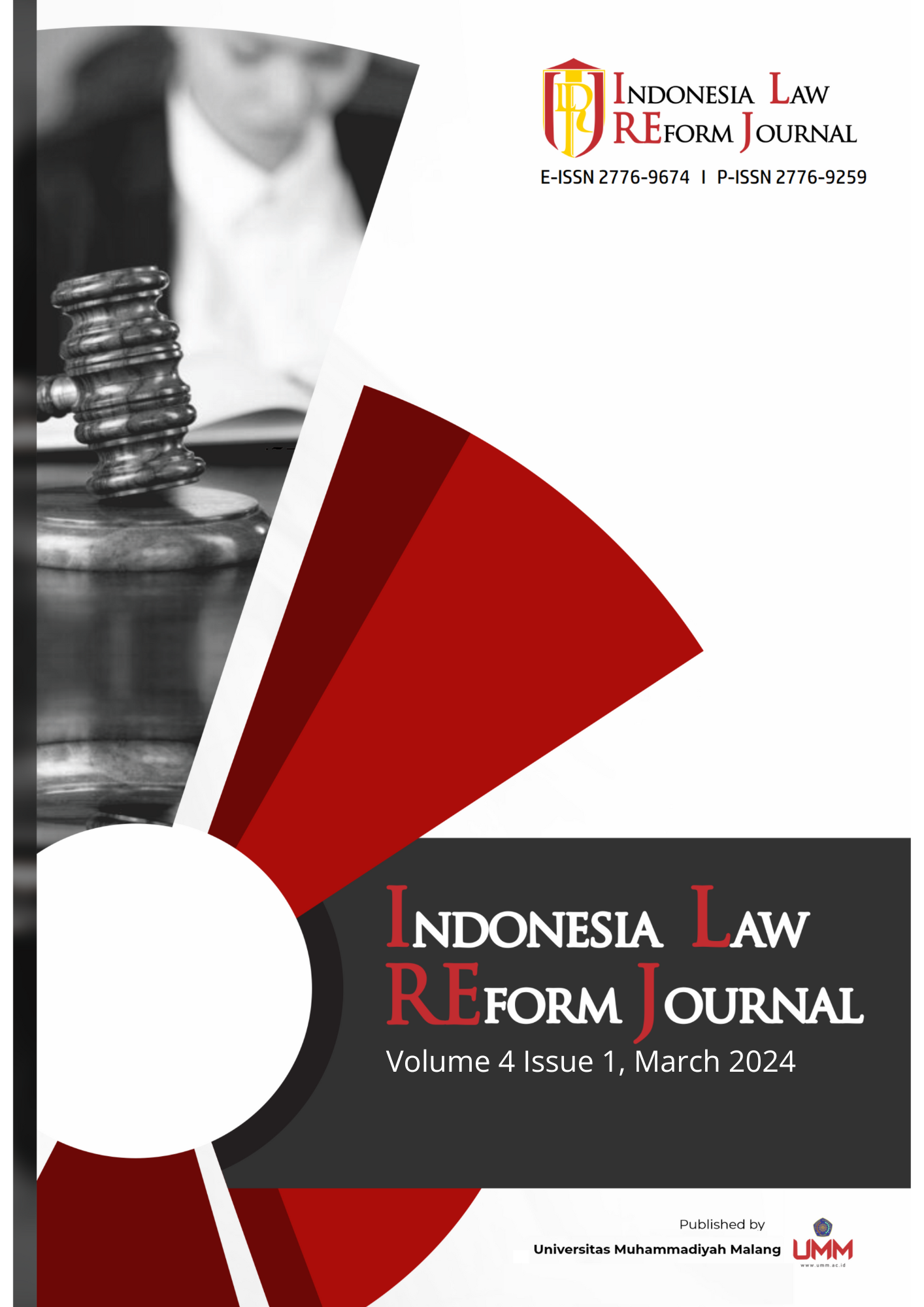Comparative of The Law Enforcement Systems for Rape Against Women in Indonesia and India
DOI:
https://doi.org/10.22219/ilrej.v4i1.34728Keywords:
Civil Law, Common Law, Enforcement, Rape, WomenAbstract
The aim of this research is to understand the legal system between Indonesia and India and what preventive measures are in place for the high rate of crimes involving the rape of women. Even though it is clear what the forms and types of punishment in both countries are based on the Criminal Code, with the increasing number of rapes what are the steps for courts and judges to pass sentences on perpetrators of rape and efforts to prevent them. The urgency of this writing and research is to answer how the English and Roman legal systems compare. The research method used is normative (Legal Research) and other data sources, namely primary legal sources listed such as Law Number 39 of 1999, Law Number 65 of 2005, Law Number 12 of 2022, Indonesian Criminal Code, Indian Criminal Code, Indian National Commission Act 1990, Indian Criminal Law Amendment 2013 and Indian Criminal Law Amendment 2018. The novelty of this research is the explanation of enforcement with differences in rape legal systems. The results of this research are that the enforcement of rape law in Indonesia is that judges are not bound by anything and anyone in handing down decisions (Inquisitorial) and are based on the Criminal Code (Codification), whereas India takes previous judges' decisions in similar cases in higher courts (Precedent) with presenting several legal experts (Doctrine) and making the Criminal Code a source of law (Statute). Indonesia's preventive efforts include establishing the National Commission on Violence Against Women and passing the TPKS Law. Meanwhile, the Indian state formed a National Commission for women with the involvement of Indian women activists to fight rape.
Downloads
References
Ashila, Bestha Inastan, Gita Nadia Pramesa, Maria Isabel Tarigan, Meyriza Vyolyta, and Kharishanty Soufi Aulia. Pedoman Pendamping Perempuan Berhadapan Dengan Hukum. Depok: Badan Pembangunan Internasional Amerika Serikat (USAID), 2019. https://mappifhui.org/wp-content/uploads/2019/08/Booklate-MaPPI-Revisi-Final-06.pdf.
Badan Pusat Statistik. “2022 Perempuan dan Laki-Laki di Indonesia.” Jakarta: Badan Pusat Statistik, 2022. https://www.bps.go.id/id/publication/2022/12/16/a37fb493455d772274cc2314/perempuan-dan-laki-laki-di-indonesia-2022.html.
Badan Pusat Statistik. “Statistik Kriminal 2021.” Jakarta: Badan Pusat Statistik, 2021. https://www.bps.go.id/id/publication/2021/12/15/8d1bc84d2055e99feed39986/statistik-kriminal-2021.html.
Badan Pusat Statistik. “Statistik Kriminal 2022.” Jakarta: Badan Pusat Statistik, 2022. https://www.bps.go.id/id/publication/2022/11/30/4022d3351bf3a05aa6198065/statistik-kriminal-2022.html.
Badan Pusat Statistik. “Statistik Kriminal 2023.” Jakarta: Badan Pusat Statistik, 2023. https://www.bps.go.id/id/publication/2023/12/12/5edba2b0fe5429a0f232c736/statistik-kriminal-2023.html.
Baiyinit. “Pertimbangan Hakim Atas Tindak Pidana Pemerkosaan Dengan Kekerasan Terhadap Perempuan Berdasarkan Pasal 285 KUHP” 3, no. 4 (2023).
Bhat, Rouf, and Mohd Wani. “Development of Women’s Movement in India: A Historical Perspective.” Temida 25, no. 1 (2022): 93–109. https://doi.org/10.2298/TEM2201093B.
Cambridge University Press. “Definition of Jury.” Accessed June 13, 2024. https://dictionary.cambridge.org/dictionary/english/jury.
Dash, Preeti Pratishruti. “Rape Adjudication in India in the Aftermath of Criminal Law Amendment Act, 2013: Findings from Trial Courts of Delhi.” Indian Law Review 4, no. 2 (May 3, 2020): 244–66. https://doi.org/10.1080/24730580.2020.1768774.
Gozali, D. S. Pengantar Perbandingan Sistem Hukum (Civil Law, Common Law, dan Hukum Adat). Bandung: Nusa Media, 2020. https://repo-dosen.ulm.ac.id/bitstream/handle/123456789/32302/perbandingan%20hukum%20rev%203.pdf?sequence=1&isAllowed=y.
Hamzah, Andi. KUHP dan KUHAP. Jakarta: Rineka Cipta, 2016.
Heriyanto, Heriyanto. “Patriarchal Culture, Theology and State Hegemony in Issues of Gender Equality in Indonesian Politics.” In Proceedings of the International Conference Social - Humanities in Maritime and Border Area (SHIMBA 2023), edited by Azhari Setiawan, Rizky Octa Putri Chairin, Rizqi Apriani Putri, Agung Dhamar Syakti, Hilfi Pardi, ONanong Thippimol, Ziaul Haque Munim, Jalaluddin Abdul Malek, and Andi Misbahul Pratiwi, 799:11–15. Advances in Social Science, Education and Humanities Research. Paris: Atlantis Press SARL, 2023. https://doi.org/10.2991/978-2-38476-150-0_3.
“In the High Court of Judicature at Bombay Criminal Apellate Jurisdiction Confirmation Case No. 2 of 2014,” n.d.
“In the Supreme Court of India,” n.d.
Indonesia, Pemerintah Pusat. Undang-Undang Nomor 31 Tahun 1999 tentang Pemberantasan Tindak Pidana Korupsi, 31 § (n.d.).
Jain, M. “Why The Pending Cases Are Increasing Year By Year In India?,” 2024. https://www.legalserviceindia.com/legal/article-13171-why-the-pending-cases-are-increasing-year-by-year-in-india-.html#:~:text=The%20only%20reason%20behind%20pendency,of%20judges.
Jamaludin, Rodliyah, and Pancaningrum. “Perlindungan Hukum Bagi Korban Tindak Pidana Pemerkosaan Perspektiv Viktimologi Dalam Sistem Peradilan Pidana.” Jurnal Kertha Semaya 9, no. 12 (2021): 2429. https://doi.org/10.24843/KS.2021.v09.i12.p14.
James, J. “Not The Right People’: Why Jury Trials Were Abolished in India,” 2020. https://www.sociolegalreview.com/post/not-the-right-people-why-jury-trials-were-abolished-in-india.
Kasera, Pamini. “A Historical Analysis of Rape Laws in India.” SSRN Electronic Journal, 2020. https://doi.org/10.2139/ssrn.3619807.
Keppres No. 181 Tahun 1998 (1998). https://peraturan.bpk.go.id/Details/59464/keppres-no-181-tahun-1998.
Kumorotomo, Wahyudi, Fajar Nurhardianto, and Inu Kencana Syafiie. “Perbandingan Sistem Hukum Civil Law Dan Common Law Dalam Penerapan Yurisprudensi Ditinjau Dari Politik Hukum” 2 (2022): 1028.
Mehta, Kalika, and Avantika Tiwari. “Between Sexual Violence and Autonomy: Rethinking the Engagement of the Indian Women’s Movement with Criminal Law.” German Law Journal 22, no. 5 (August 2021): 860–77. https://doi.org/10.1017/glj.2021.40.
Ministry of Law and Justice. Criminal Law Amendment Act 2013 (2013). https://www.iitk.ac.in/wc/data/TheCriminalLaw.pdf.
Ministry of Statistics and Programme Implementation. “Women and Men 2022.” New Delhi: Ministry of Statistics and Programme Implementation, 2022. https://mospi.gov.in/publication/women-men-india-2022.
Muhaimin. Metode Penelitian Hukum. Mataram: Mataram University Press, 2020. http://eprints.unram.ac.id/20305/1/Metode%20Penelitian%20Hukum.pdf.
Muhrim, Cantika W, Sherly Adam, and Elias Zadrach Leasa. “Pertimbangan Hukum Hakim Terhadap Kesaksian Yang Meringankan Dalam Tindak Pidana Pemerkosaan.” TATOHI: Jurnal Ilmu Hukum 2, no. 10 (December 20, 2022): 1033. https://doi.org/10.47268/tatohi.v2i10.1442.
National Crime Records Bureau. “Crime in India 2020.” New Delhi: National Crime Records Bureau, 2021. https://ncrb.gov.in/en/crime-in-india-table-addtional-table-and-chapter-contents.
National Crime Records Bureau. “Crime in India 2021.” New Delhi: National Crime Records Bureau, 2022. https://ncrb.gov.in/en/crime-in-india-table-addtional-table-and-chapter-contents.
National Crime Records Bureau. “Crime in India 2022.” New Delhi: National Crime Records Bureau, 2023. https://ncrb.gov.in/uploads/nationalcrimerecordsbureau/custom/1701607577CrimeinIndia2022Book1.pdf.
Nur Khumaeroh, Irda. “Kebijakan Hukum Pidana Terhadap Perkembangan Tindak Pidana Kekerasan Seksual yang Bertujuan Menciptakan Keadilan Gender.” Jurnal Hukum Indonesia 2, no. 2 (April 27, 2023): 53–59. https://doi.org/10.58344/jhi.v2i2.14.
Perpres Nomor 65 Tahun 2005 (2005). https://peraturan.bpk.go.id/Details/42592/perpres-no-65-tahun-2005.
Priyanka, Singh, and Dixit Anjali. “Comparative Study of Rape Legislation for Men and Women in India.” International Journal For Multidisciplinary Research 5, no. 6 (December 4, 2023): 9914. https://doi.org/10.36948/ijfmr.2023.v05i06.9914.
Purwati, Yayi, Kuswardani Kuswardani, and Arief Budiono. “Comparison of the Rape Law in the Indonesian Penal Code and the Indian Penal Code:” Surakarta, Indonesia, 2022. https://doi.org/10.2991/assehr.k.220501.019.
“Putusan_151_pid.B_2020_pn_kot.Pdf,” n.d.
Sabharwal, Meghna. “Rising Gender Inequities in India: The Case of Authoritarian Patriarchy*.” Journal of Social Equity and Public Administration 1, no. 1 (2023): 70. https://doi.org/10.24926/jsepa. v1i1.4929.
Sabrina, Thuong. “15 Bentuk Kekerasan Seksual Sebuah Pengenalan.” Komnas Perempuan, 2020. https://komnasperempuan.go.id/download-file/415.
Shodiq, MD. Perbandingan Sistem Hukum. Solok, 2023.
Sibarani, Rinto, Tomi Suhendra Pardede, Yuleo Foonasan Hussi, and Abdurrakhman Alhakim. “Kajıan Hukum Terhadap Korban Pemerkosaan: Perspektıf Hukum dı Indonesıa” 1, no. 1 (2021).
Singh, Abhishek, Praveen Chokhandre, Ajeet Kumar Singh, Kathryn M. Barker, Kaushalendra Kumar, Lotus McDougal, K. S. James, and Anita Raj. “Development of the India Patriarchy Index: Validation and Testing of Temporal and Spatial Patterning.” Social Indicators Research 159, no. 1 (January 2022): 351–77. https://doi.org/10.1007/s11205-021-02752-1.
Singh, Swati. “Rape vs Patriarchy : A Sociological Analysis.” Society and Culture Development in India 1, no. 2 (2021): 192. www.arfjournals.com.
Star, Shaun, and Arindam Bharadwaj. “Trial by Jury in Australia and India.” Comparative Reflection on the Constitutional Model of India and Australia, 2020, 6.7.
Surbakti, Debby Pratiwi, Suriani Siagian, Emmi Rahmiwita Nasution, and Fakultas Hukum Universitas Asahan. “Bentuk Perlindungan Bagi Perempuan yang Dipekerjakan Sebagai Pekerja Seks Komersil (PSK).” DE LEGA LATA: Jurnal Ilmu Hukum 5, no. 2 (July 20, 2020): 115–23. https://doi.org/10.30596/dll.v5i2.3571.
The Criminal Law Amandment Act 2018 (2018). https://www.mha.gov.in/sites/default/files/2023-02/CSdivTheCriminalLawAct_27022023.pdf.
The National Commision for Women Act 1990 (1990). https://wcd.nic.in/sites/default/files/ncwact.pdf.
Undang-Undang Nomor 12 Tahun 2022 (2022). https://peraturan.bpk.go.id/Details/207944/uu-no-12-tahun-2022.
Zulfiko, Riki. “Paradigma Sexsual Consent Dalam Pembaharuan Tindak Pidana Kekerasan Seksual.” Pagaruyuang Law Journal 5, no. 2 (February 1, 2022): 104–22. https://doi.org/10.31869/plj.v5i2.3151.
Downloads
Published
How to Cite
Issue
Section
License
Copyright (c) 2024 Altiah Septiani, Ulil Albab

This work is licensed under a Creative Commons Attribution-ShareAlike 4.0 International License.











